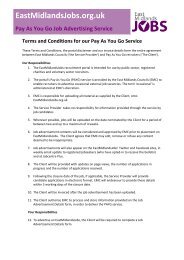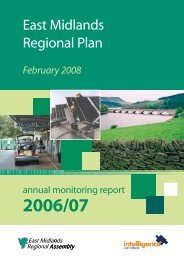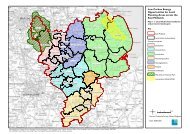East Midlands Regional Spatial Strategy 2005/06
East Midlands Regional Spatial Strategy 2005/06
East Midlands Regional Spatial Strategy 2005/06
Create successful ePaper yourself
Turn your PDF publications into a flip-book with our unique Google optimized e-Paper software.
Table 8.17- Continued<br />
Broxtowe<br />
Gedling<br />
Rushcliffe<br />
3 Cities Derby<br />
3 Cities Leicester<br />
3 Cities Nottingham<br />
3 Cities<br />
Additional dwellings*<br />
(new build, conversion and<br />
change of use) 04/05<br />
345<br />
259<br />
483<br />
1,956<br />
3,505<br />
2,616<br />
8,077<br />
Additional dwellings*<br />
(new build, conversion and<br />
change of use) 05/<strong>06</strong><br />
380<br />
263<br />
322<br />
1,839<br />
3,552<br />
3,<strong>06</strong>2<br />
8,453<br />
Source: Local Authorities<br />
* figures shown are gross completions (excludes losses through demolitions, conversions and changes of use)<br />
<strong>East</strong> <strong>Midlands</strong> <strong>Regional</strong> <strong>Spatial</strong> <strong>Strategy</strong> Annual Monitoring Report <strong>2005</strong>/<strong>06</strong><br />
Table 8.18 - Change in the number of jobs<br />
Amber Valley<br />
Blaby<br />
Broxtowe<br />
Charnwood<br />
Derby<br />
Erewash<br />
Gedling<br />
Harborough<br />
Hinckley & Bosworth<br />
Leicester<br />
Melton<br />
North West<br />
Leicestershire<br />
Nottingham<br />
Oadby & Wigston<br />
Rushcliffe<br />
South Derbyshire<br />
3 Cities Derby<br />
3 Cities Leicester<br />
3 Cities Nottingham<br />
3 Cities Sub Area<br />
<strong>East</strong> <strong>Midlands</strong><br />
Number of jobs<br />
2001<br />
53,742<br />
34,502<br />
31,260<br />
54,624<br />
118,546<br />
38,743<br />
32,671<br />
28,979<br />
38,575<br />
158,981<br />
17,474<br />
42,542<br />
179,914<br />
17,057<br />
35,146<br />
21,511<br />
193,799<br />
392,734<br />
317,735<br />
904,268<br />
1,760,820<br />
Number of jobs<br />
2004*<br />
47,657<br />
41,470<br />
33,384<br />
59,504<br />
116,502<br />
33,384<br />
27,796<br />
33,308<br />
40,455<br />
158,270<br />
18,180<br />
46,990<br />
182,071<br />
18,117<br />
38,498<br />
29,160<br />
193,319<br />
416,294<br />
318,911<br />
930,202<br />
1,803,659<br />
Number of Jobs<br />
<strong>2005</strong><br />
48,251<br />
45,589<br />
35,329<br />
58,741<br />
121,161<br />
35,329<br />
29,967<br />
34,049<br />
40,916<br />
159,556<br />
19,193<br />
48,357<br />
184,911<br />
18,848<br />
43,169<br />
30,326<br />
199,738<br />
425,250<br />
332,823<br />
960,485<br />
1,858,204<br />
% change 2004/05<br />
Source: Annual Business Inquiry<br />
* 2004 data has been revised by ONS and differs from that published in the previous monitoring report<br />
1.2<br />
9.9<br />
5.8<br />
-1.3<br />
4.0<br />
5.8<br />
7.8<br />
2.2<br />
1.1<br />
0.8<br />
5.6<br />
2.9<br />
1.6<br />
4.0<br />
12.1<br />
4.0<br />
3.3<br />
2.6<br />
4.4<br />
3.3<br />
3.0<br />
154
















